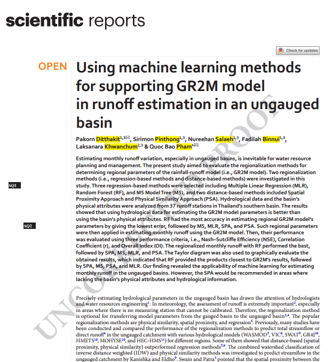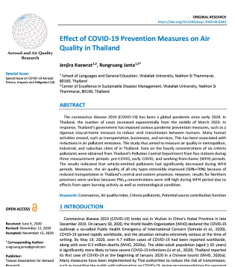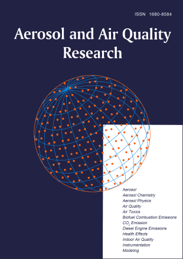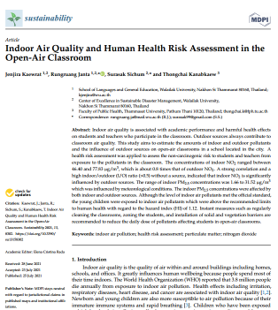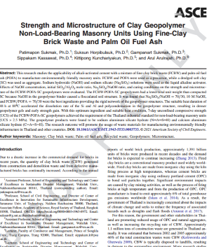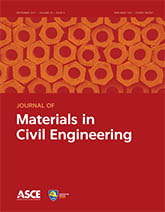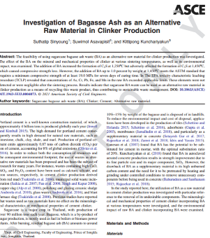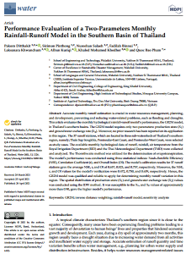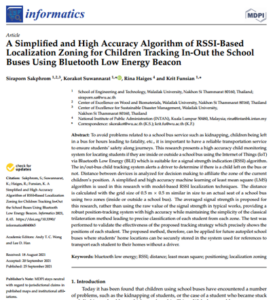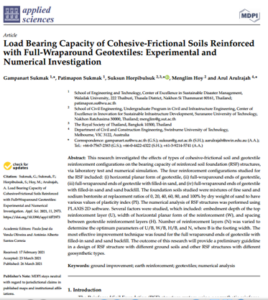ผลงานตีพิมพ์ในวารสารที่อยู่ใน SCOPUS Q1 ที่มีค่า Percentile มากกว่า 90
จำนวน 3 ผลงาน
Abstract
For decades, recycled coarse aggregate (RCA) has been used to make recycled aggregate concrete (RAC). Numerous studies have compared the mechanical properties and durability of recycled aggregate concrete (RAC) to those of natural aggregate concrete (NAC). However, test results on the shear strength of reinforced recycled aggregate concrete beams are still limited and sometimes contradictory. Shear failure is generally brittle and must be prevented. This article studies experimentally and analytically the shear strength of reinforced RAC beams without stirrups. Eight RAC beams and two controlled NAC beams were tested under the four-point flexural test with the shear span-to-effective depth ratio (a/d) of 3.10. The main parameters investigated were the replacement percentage of RCA (0%, 25%, 50%, 75%, and 100%) and longitudinal reinforcement ratio (ρw) of 1.16% and 1.81%. It was found that the normalized shear stresses of RAC beams with ρw = 1.81% at all levels of replacement percentage were quite similar to those of the NAC counterparts. Moreover, the normalized shear stress of the beam with 100% RCA and ρw = 1.16% was only 6% lower than that of the NAC beam. A database of 128 RAC beams without shear reinforcement from literature was analyzed to evaluate the accuracy of the ACI 318-19 shear provisions in predicting the shear strength of the beams. For an RCA replacement ratio of between 50% and 100%, it was proposed to apply a reduction factor of 0.75 to the current ACI code equation to account for the physical variations of RCA, such as replacement percentage, RCA source and quality, density, amount of residual mortar, and physical irregularity. View Full-Text
Abstract
Estimating monthly runoff variation, especially in ungauged basins, is inevitable for water resource planning and management. The present study aimed to evaluate the regionalization methods for determining regional parameters of the rainfall-runoff model (i.e., GR2M model). Two regionalization methods (i.e., regression-based methods and distance-based methods) were investigated in this study. Three regression-based methods were selected including Multiple Linear Regression (MLR), Random Forest (RF), and M5 Model Tree (M5), and two distance-based methods included Spatial Proximity Approach and Physical Similarity Approach (PSA). Hydrological data and the basin’s physical attributes were analyzed from 37 runoff stations in Thailand’s southern basin. The results showed that using hydrological data for estimating the GR2M model parameters is better than using the basin’s physical attributes. RF had the most accuracy in estimating regional GR2M model’s parameters by giving the lowest error, followed by M5, MLR, SPA, and PSA. Such regional parameters were then applied in estimating monthly runoff using the GR2M model. Then, their performance was evaluated using three performance criteria, i.e., Nash–Sutcliffe Efficiency (NSE), Correlation Coefficient (r), and Overall Index (OI). The regionalized monthly runoff with RF performed the best, followed by SPA, M5, MLR, and PSA. The Taylor diagram was also used to graphically evaluate the obtained results, which indicated that RF provided the products closest to GR2M’s results, followed by SPA, M5, PSA, and MLR. Our finding revealed the applicability of machine learning for estimating monthly runoff in the ungauged basins. However, the SPA would be recommended in areas where lacking the basin’s physical attributes and hydrological information.
Abstract
ผลงานตีพิมพ์ในวารสารที่อยู่ใน SCOPUS Q1 ที่มีค่า Percentile มากกว่า 75-90
จำนวน 8 ผลงาน
Abstract
The coronavirus disease 2019 (COVID-19) has been a global pandemic since early 2020. In Thailand, the number of cases increased exponentially from the middle of March 2020. In response, Thailand’s government has imposed various pandemic prevention measures, such as a rigorous stay-at-home measure to reduce viral transmission between humans. Many human activities ceased, such as transportation, businesses, and services. This has been associated with reductions in air pollutant emissions. This study thus aimed to measure air quality in metropolitan, industrial, and suburban cities of in Thailand. Data on the hourly concentrations of six criteria pollutants were obtained from Thailand’s Pollution Control Department from five stations during three measurement periods: pre-COVID, early COVID, and working-from-home (WFH) periods. The results indicated that vehicle-emitted pollutants had significantly decreased during WFH periods. Moreover, the air quality of all city types ostensibly improved (50%–70%) because of reduced transportation in Thailand’s central and eastern provinces. However, results for Northern provinces were unclear because PM2.5 concentrations were still high during WFH period due to effects from open burning activity as well as meteorological condition.
Abstract
The coronavirus disease 2019 (COVID-19) has been a global pandemic since early 2020. In Thailand, the number of cases increased exponentially from the middle of March 2020. In response, Thailand’s government has imposed various pandemic prevention measures, such as a rigorous stay-at-home measure to reduce viral transmission between humans. Many human activities ceased, such as transportation, businesses, and services. This has been associated with reductions in air pollutant emissions. This study thus aimed to measure air quality in metropolitan, industrial, and suburban cities of in Thailand. Data on the hourly concentrations of six criteria pollutants were obtained from Thailand’s Pollution Control Department from five stations during three measurement periods: pre-COVID, early COVID, and working-from-home (WFH) periods. The results indicated that vehicle-emitted pollutants had significantly decreased during WFH periods. Moreover, the air quality of all city types ostensibly improved (50%–70%) because of reduced transportation in Thailand’s central and eastern provinces. However, results for Northern provinces were unclear because PM2.5 concentrations were still high during WFH period due to effects from open burning activity as well as meteorological condition.
Abstract
This research studies the applicability of alkali-activated cement with a mixture of fine-clay brick waste (FCBW) and palm oil fuel ash (POFA) to manufacture environmentally friendly masonry units. FCBW and POFA were used as a precursor, while a dredged soft clay (SC) was used as aggregate. Sodium hydroxide (NaOH) and sodium silicate (Na2SiO3Na2SiO3) solutions were used as the liquid alkaline activator. Effects of NaOH concentration, initial SiO2/Al2O3SiO2/Al2O3 mole ratio, Na2SiO3/NaOHNa2SiO3/NaOH ratio, and curing conditions on the strength and microstructure of the FCBW-POFA-SC geopolymers were evaluated. The FCBW-POFA-SC geopolymers had a lower total unit weight than compacted SC because NaOH in the geopolymer binder caused a flocculated soil structure. It was found that Na2SiO3/NaOH=70/30Na2SiO3/NaOH=70/30, 10 M10 M NaOH, and FCBW/POFA=70/30FCBW/POFA=70/30 were the best ingredients providing the rigid network of the geopolymer structures. The suitable heat duration of 48 h48 h at 80°C accelerated the dissolution rate of the Si and Al and polycondensation in the geopolymer structure, resulting in denser geopolymer gels and early strength gain. With this optimum ingredient and suitable heat condition, 7-day unconfined compressive strength (UCS) of the FCBW-POFA-SC geopolymers achieved the requirement of the Thailand industrial standard for non-load-bearing masonry units (UCS>2.5 MPaUCS>2.5 MPa). The geopolymer products were found to be sodium aluminum silicate hydrate (N─ A─ S─ H) and calcium aluminum silicate hydrate (C─ A─ S─ H). The research outcome will promote the usage of waste materials for manufacturing environmentally friendly infrastructure in Thailand and other countries.
Abstract
The feasibility of using sugarcane bagasse ash waste (BA) as an alternative raw material for clinker production was investigated. The effect of the BA on the mineral and mechanical properties of clinker at various sintering temperatures, as well as its environmental impact, was examined. The addition of BA increased the formation of C2SC2S at 1,250°C but adversely affected the formation of C3SC3S at 1,450°C, which caused compressive strength loss. However, the addition of BA up to 1.0 percent by weight at 1,450°C meets the ASTM standard that requires a minimum compressive strength of at least 19.0 MPa for seven days of curing time. In The EPA toxicity characteristic leaching procedure (TCLP) revealed that concentrations of As, Cr, Pb, Fe, and Mn in the raw BA exceeded applicable limits These elements were not detected or were negligible after the sintering process. Results indicate that sugarcane BA waste can be used as an alternative raw material in clinker production as a means of recycling this waste product, thus contributing to sustainable waste management.
Abstract
The use of Ecofonts in printing can result in economic savings and lower environmental impact. However, most of the research on the use of Ecofonts focuses on Latin alphabets. Moreover, texts printed with Ecofonts can be perceived as being less legible than those printed with the original typefaces. This study (a) assesses toner use reductions in documents printed with English and Thai Ecofonts, and (b) studies the observers’ perception of texts printed either with Ecofonts or with original typefaces. To achieve this, black pixels were removed from 10 English and 13 Thai typefaces widely used in academia and other media. Visibility and legibility tests, as well as mass analyses tests, were then performed on texts printed with some such typefaces. Results from instrumental measurements and digital image analyses show that the use of Ecofonts reduces toner use of an inkjet printer by up to 28%. The study also proposes a new Ecofont typeface for the Thai language. Visual tests showed that the visual experience of text printed using this Thai Ecofont is satisfactory. Awareness of the benefits of using Ecofonts changes the users’ attitudes towards the printing quality of Ecofont. The removal of black pixels can lead to more sustainable printing, and this simple solution can be extended to other non-Latin languages as part of the global Green Information Technology efforts in South-East Asia. View Full-Text
Abstract
Accurate monthly runoff estimation is crucial in water resources management, planning, and development, preventing and reducing water-related problems, such as flooding and droughts. This article evaluates the monthly hydrological rainfall-runoff model’s performance, the GR2M model, in Thailand’s southern basins. The GR2M model requires only two parameters: production store (X1) and groundwater exchange rate (X2). Moreover, no prior research has been reported on its application in this region. The 37 runoff stations, which are located in three sub-watersheds of Thailand’s southern region, namely; Thale Sap Songkhla, Peninsular-East Coast, and Peninsular-West Coast, were selected as study cases. The available monthly hydrological data of runoff, rainfall, air temperature from the Royal Irrigation Department (RID) and the Thai Meteorological Department (TMD) were collected and analyzed. The Thornthwaite method was utilized for the determination of evapotranspiration. The model’s performance was conducted using three statistical indices: Nash–Sutcliffe Efficiency (NSE), Correlation Coefficient (r), and Overall Index (OI). The model’s calibration results for 37 runoff stations gave the average NSE, r, and OI of 0.657, 0.825, and 0.757, respectively. Moreover, the NSE, r, and OI values for the model’s verification were 0.472, 0.750, and 0.639, respectively. Hence, the GR2M model was qualified and reliable to apply for determining monthly runoff variation in this region. The spatial distribution of production store (X1) and groundwater exchange rate (X2) values was conducted using the IDW method. It was susceptible to the X1, and X2 values of approximately more than 0.90, gave the higher model’s performance. View Full-Text
Abstract
This research investigated the effects of types of cohesive-frictional soil and geotextile reinforcement configurations on the bearing capacity of reinforced soil foundation (RSF) structures, via laboratory test and numerical simulation. The four reinforcement configurations studied for the RSF included: (i) horizontal planar form of geotextile, (ii) full-wraparound ends of geotextile, (iii) full-wraparound ends of geotextile with filled-in sand, and (iv) full-wraparound ends of geotextile with filled-in sand and sand backfill. The foundation soils studied were mixtures of fine sand and sodium bentonite at replacement ratios of 0, 20, 40, 60, 80, and 100% by dry weight of sand to have various values of plasticity index (PI). The numerical analysis of RSF structures was performed using PLAXIS 2D software. Several factors were studied, which included: embedment depth of the top reinforcement layer (U), width of horizontal planar form of the reinforcement (W), and spacing between geotextile reinforcement layers (H). Number of reinforcement layers (N) was varied to determine the optimum parameters of U/B, W/B, H/B, and N, where B is the footing width. The most effective improvement technique was found for the full wraparound ends of geotextile with filled-in sand and sand backfill. The outcome of this research will provide a preliminary guideline in a design of RSF structure with different ground soils and other RSF structures with different geosynthetic types. View Full-Text
Abstract
To avoid problems related to a school bus service such as kidnapping, children being left in a bus for hours leading to fatality, etc., it is important to have a reliable transportation service to ensure students’ safety along journeys. This research presents a high accuracy child monitoring system for locating students if they are inside or outside a school bus using the Internet of Things (IoT) via Bluetooth Low Energy (BLE) which is suitable for a signal strength indication (RSSI) algorithm. The in/out-bus child tracking system alerts a driver to determine if there is a child left on the bus or not. Distance between devices is analyzed for decision making to affiliate the zone of the current children’s position. A simplified and high accuracy machine learning of least mean square (LMS) algorithm is used in this research with model-based RSSI localization techniques. The distance is calculated with the grid size of 0.5 m × 0.5 m similar in size to an actual seat of a school bus using two zones (inside or outside a school bus). The averaged signal strength is proposed for this research, rather than using the raw value of the signal strength in typical works, providing a robust position-tracking system with high accuracy while maintaining the simplicity of the classical trilateration method leading to precise classification of each student from each zone. The test was performed to validate the effectiveness of the proposed tracking strategy which precisely shows the positions of each student. The proposed method, therefore, can be applied for future autopilot school buses where students’ home locations can be securely stored in the system used for references to transport each student to their homes without a driver. View Full-Text
รายละเอียดผลงานวิจัย




